| ENVIS Technical Report: 90, April 2015 |
1Energy and Wetlands Research Group, Centre for Ecological Sciences,
2Centre for Sustainable Technologies (astra)
3 Centre for infrastructure, Sustainable Transportation and Urban Planning [CiSTUP],
Indian Institute of Science, Bangalore, Karnataka, 560 012, India
Web: http://ces.iisc.ac.in/energy
E Mail: cestvr@ces.iisc.ac.in; ganesh@ces.iisc.ac.in
Tel: 91-080-22933099, 2293 3503 extn 101, 107, 114
4Adamya Chetana, Annapoorna - Bangalore, Community Hall,
Kempegowda Nagar, Bengaluru, Karnataka 560019
Tel: 080 2662 0404, E Mail: tejaswini.acf@gmail.com
5
R K Mission, Shivanahalli, Anekal, Bangalore,
E Mail: vishnumayananda@gmail.com
*Corresponding author: cestvr@ces.iisc.ac.in
|
|
RENEWABLE ENERGY OPTIONS THROUGH SOLAR ROOFTOP PV AND SOLAR MICRO-GRID
Energy
Domestic Electricity: Villages in Ragihalli panchayat are electrified, yet there are few households without electricity. Domestic lighting, televisions and few irrigation pump sets are the major loads in the village. Industrial and commercial consumption is negligible in this panchayat. Figure 18 shows the connected load profile and average monthly electricity consumption in Ragihalli and Shivanahalli village.
 |
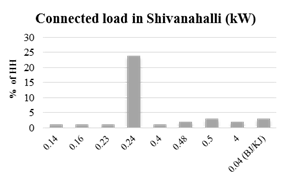
|

|
Figure 18: Connected loads and electricity consumption profile |
Most of the houses in the villages have connected load of 0.24 kW (20% in Ragihalli and 24% in Shivanahalli) where the electric appliances include CFL and fluorescent lamps, television, mixer and mobile charger. Few households with higher connected load have refrigerator and heating equipment. There are significant number of Bhagya Jyothi and Kuteera Jyothi (free electricity for BPL card holders) connection, who consume electricity less than 35 kWh per month. The average monthly electricity consumption was about 50 to 75 kWh which was mostly less than 100 kWh/month.
Street lighting: Ragihalli and Shivanahalli are provided with street lights while other 14 villages have few street lights in the common places. Many of the mountings and lamps have to be repaired and regular maintenance is required. Solar street lights can be an alternate option in the remote villages. Local youngsters have to be trained for regular maintenance and minor repair of street lights.
Cooking and Heating Energy: Most of the households in the panchayat use LPG for cooking and biomass (fuel wood and agricultural residues) for heating water. Villagers use traditional cook stoves for which they collect fuelwood from nearby forest and use agriculture residue. Availability of biomass is declining due to less crop yield and declining trees in forests and some parts of forests are inaccessible. Technological intervention through alternate energy sources can indeed help villagers while saving fuelwood collection time.
Interventions: Renewable energy Options through solar rooftop PV and solar Micro-grid
The village receives abundant solar energy throughout the year which ranges from 4.4 to 6.5 kWh/m2/day. Figure 19 shows the solar energy and wind speed variation across the months. The region experience lower wind speed throughout the year which may support low speed turbines for mechanical and electrical energy generation. However, decentralised solar PV and solar water heaters can be installed in barren areas or rooftop.
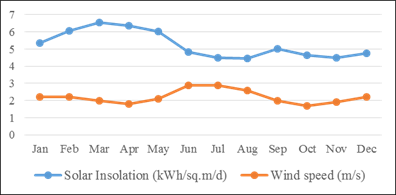
Figure 19: Solar energy and wind speed variation
Solar water heater is a viable option in the village since many households are dependent on traditional cook stove for water heating and fuel wood availability is a limiting factor. Table 6 gives the techno-economic details of the rooftop solar water heater.
Table 6: Techno-economic details of the rooftop solar water heater
|
Specifications |
Weight |
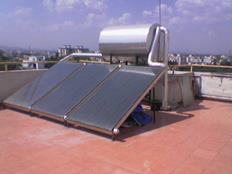
|
Collector area |
2 m2 (2 kW) |
50 kg |
Storage Tank |
100 lt./day |
120-140 kg |
Installation area |
4.5 – 5 m2 |
|
Total cost (INR) |
18,000 – 25,000 |
|

Domestic Energy: Electricity generation from solar PV can meet the domestic energy demand locally. Though most of the households in the villages are connected to the grid, electricity supply is not reliable. Decentralised electricity generation using renewable energy sources and distribution through micro grids can superior quality energy to the households for domestic consumption. However, micro grids can be connected to the central grid and energy exchange mechanism can be established. Table 7 gives the comparison between individual SPV installations for each household and community micro grid for the region. Community level electricity generation with fee-for-service model can be feasible option in the region which also generates employment and effective revenue collection is possible.
Heating Energy: Community Solar Water Heater |
Discussion with villagers on 4th and 11th of March 2014, helped to understand the willingness to adopt intervention in the region. Though villagers have disagreed for common bathrooms, they appreciated the provision of hot water through community solar water heater (installed in each lane). A fee-for-service model will be established where consumer will have to pay for the hot water. A fee of Rs 1 for a bucket (10l) of hot water would make the system economically viable. Two or three youths in the villages be trained to maintain the account and to maintain the system. E-payment could be employed through card swiping and dynamic pricing can be implemented eventually. |
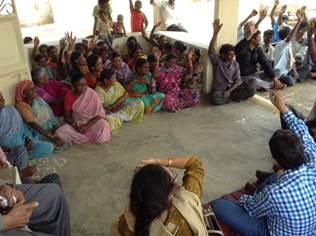
|

|
Design of community solar water heater
Table 8: Design specifications of community solar water heater
|
Specifications |
Comments |
No. of water heating and distributing units |
Minimum one unit for 20 homes with two outlets |
|
Water distribution |
15 litres per person per day |
|
Cost of water |
INR 3 for first 15 lt.
INR 2 for every extra 5 lt. |
|
Human resource requirement |
2 persons/unit |
In every village, 2 persons to take care of fee collection once in a week and maintain the register |
Operating time |
8.00 to 10.00 in the morning |
|
Fee collection |
Through swipe cards and money transfer once in a week |
|
Capacity |
1000 litres |
|
Collector area |
12 m2 |
Total area is about 20 m2 and the tank should be placed at least 4 to 5 feet above ground |
Livestock - Cattle Farming
Cattle is an important element of agrarian village community for manure and milk production. They have been also used for transportation and sowing which is reduced in recent years due to mechanised agriculture. Most of the households in the panchayat has cattle (either native or high milk yielding variety) where the milk production is an important activity. Table 9 shows the cattle population in the village.
Table 9: Cattle population
Category |
Number |
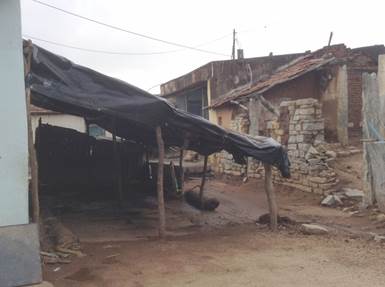
|
Cows |
894 |
Sheep |
959 |
Goat |
968 |
Hen |
985 |
Village has a good potential to generate biogas and organic manure from cattle residue. It is estimated that about 2896 m3 of biogas can be generated and more than 5 tonnes of organic manure can be produced apart from milk generation. There are very few biogas plants are present in the village, where most of the dung is sold to the farmers locally. Cattle sheds are in poor condition with unhygienic surroundings where cattle are mostly exposed to sunlight, cold and rain. Fodder availability is limited since agriculture residue are less and forage crops are not grown. Lack of cooperation in milk dairy management and irregular payment to the farmers is a serious issue to be addressed.
Intervention
Fodder cultivation has to be promoted in the village where barren lands / fallow lands are available. Use of drip irrigation and multi cropping can increase the crop residue and fodder availability. Co-operative milk dairies with automated weighing and quality checking should be introduced in the village on priority. Payments could be done through wire transfer to Jan Dhan account, which makes the system efficient and transparent. Farmers be given training for scientific cattle farming. The following interventions can increase the economic status of farmers through cattle farming.
- Automated quality and quantity check in milk dairies
- Online payment to the beneficiaries (using Jan Dhan account or through card)
- Training on organic fertiliser production
- Promoting milk product production and marketing through Self Help Group (SHG)
- Fodder generation in barren land or as vegetative strips (Table 5)
- A cattle husbandry and a doctor with all facilities for vaccination and treatment
It is estimated that about 2893 m3 of biogas can be produced every month with more than 5 tonnes of manure in the village. It enable entrepreneurship opportunities through community cattle farming or providing common cattle shed facility. Community cattle shed is found to be successful where the effective collection of milk and residue can be done with continuously monitoring cattle health (especially the young ones). Nevertheless, a common dung collection system can be established in near future; biogas and manure can be produced with the help of SHG and youths in the village. Biogas generated can be used in community water heaters or supplied to nearby hamlet as cooking fuel. Minimum of 5 trained youths are required to maintain the biogas plant and gas supply. The slurry obtained at the outlet is nutrient rich which can be used to produce organic fertiliser. Fertiliser has high market value, which can be sold to the local farmers or in the nearby villages/towns. This completes the cycle and brings back the nutrients to the soil which makes the system more sustainable.
|
Dr. T.V. Ramachandra
Centre for Sustainable Technologies, Centre for infrastructure, Sustainable Transportation and Urban Planning (CiSTUP), Energy & Wetlands Research Group, Centre for Ecological Sciences, Indian Institute of Science, Bangalore – 560 012, INDIA.
E-mail : cestvr@ces.iisc.ac.in
Tel: 91-080-22933099/23600985,
Fax: 91-080-23601428/23600085
Web: http://ces.iisc.ac.in/energy
Ganesh HegdeEnergy & Wetlands Research Group, Centre for Ecological Sciences, Indian Institute of Science, Bangalore – 560 012, INDIA.
E-mail: ganesh@ces.iisc.ac.in
Subhash Chandran M.D.Energy & Wetlands Research Group, Centre for Ecological Sciences, Indian Institute of Science, Bangalore – 560 012, INDIA.
E-mail: mds@ces.iisc.ac.in
Tejaswini Ananth KumarAdamya Chetana, Annapoorna - Bangalore, Community Hall,
Kempegowda Nagar, Bengaluru, Karnataka 560019
E-mail: tejaswini.acf@gmail.com
Vishnumayananda SwamijiR K Mission, Shivanahalli, Anekal, Bangalore
E-mail: vishnumayananda@gmail.com
Citation:Ramachandra T V, Ganesh Hegde, Subash Chandran M D, Tejaswini Ananth Kumar and Vishnumayananda Swamiji, 2015., SMART Ragihalli: Effort towards Self-reliant & Self-sufficient system empowering Man power (rural youth) with Appropriate Rural Technologies,ETR 90, Energy & Wetlands Research Group, CES, Indian Institute of Science , Bangalore
| Contact Address : |
| |
Dr. T.V. Ramachandra
Energy & Wetlands Research Group,
Centre for Ecological Sciences, TE 15, New Biology Building, Third Floor, E Wing, [Near D Gate], Indian Institute of Science, Bangalore – 560 012, INDIA.
Tel : 91-80-22933099 / 22933503-extn 107
Fax : 91-80-23601428 / 23600085 / 23600683 [CES-TVR]
E-mail : cestvr@ces.iisc.ac.in, energy@ces.iisc.ac.in,
Web : http://wgbis.ces.iisc.ac.in/energy |
| |










